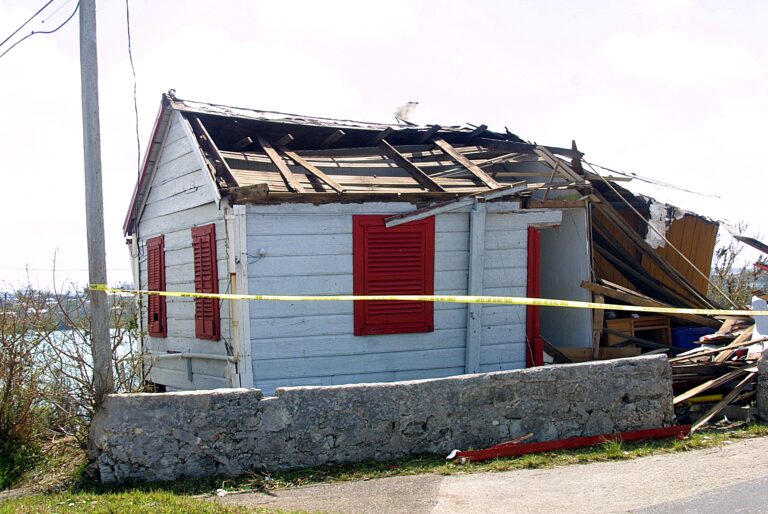by Tim Smith
The howling winds have finally subsided and at last it’s safe to step outside, breathe in some fresh air and assess the damage.
For many people, those few hours after a storm are a trip out of their comfort zone—inspecting their roof and walls like a builder, examining their trees and gardens like a horticulturalist and having to make quick decisions to tackle the vast range of unpredictable things that might have happened.
Experts agree that your first priority is to stay safe. Debris could have blown into your yard and become a hazard, and there may be live wires on the ground. They also offer the following advice on caring for your property after a storm:
Roofs
Richard Moulder, the general manager at Bermuda Paint, says: “You should be looking for new cracks. If the storm came through and your roof lifted and dropped back down, you are going to have replace that portion of the roof. Look on your ceilings on the inside for wet areas. Then you should go outside and look at your roof where those cracks were. Sometimes those cracks are so faint they are difficult to see.”
Moulder says Bermuda Paint offers advice and provides the relevant products to fix roof problems.
Walls
Salt water will make the outside of your home sticky, and debris such as leaves will attach to the walls. Moulder says: “If you are able to, you should as soon as possible wash all your exterior walls off. If you don’t do that, the leaves will stick to the wall, then they will dry. Eventually, you start getting brown stains and you can’t get them off. If you don’t deal with it, in the end you have to buy paint for a couple of hundred dollars and pay someone to paint your house.”
Insurance
Carry out a proper assessment of your property to receive funds from your insurance company to make repairs. Callan Bassett, the business development manager at Age Concern, provides the following advice, which is applicable for all residents:
1) Take photos
“After the hurricane has passed and it’s safe to venture outside, grab your camera or smartphone and start taking pictures and capturing video. Remember: be safe. Downed power lines and high water can be deadly, and it’s not worth risking your life for photos that can be taken at a later, safer time.”
2) Save receipts, stay organized
“Paperwork is crucial in the world of homeowners insurance. Securing your paperwork prior to a hurricane can alleviate headaches and problems after it’s gone. Make sure to save receipts, as many are likely to be reimbursable.”
3) Call your insurance company soon and often
“Once the hurricane has passed, it is imperative to get in touch with your insurance agent or insurer as soon as possible. Provide them with all the pictures and videos you’ve collected, as well as any paperwork you have saved, and make sure to get everything you can in writing.”
Dealing with the unpredictable
Usually, you will make repairs in conjunction with your insurance company. The Department of Parks offers an example of one occasion in which it helped out. According to a spokesperson, “The only time the Ministry has assisted residents is when there are those associated with the vulnerable populations and where the families may not have the financial resources. An example is Parks several years ago responded to a senior’s residence where a large casuarina tree was unstable and would have collapsed onto the roof when the wind speed became sustained at gale-force to storm-force. It was declared an urgent matter and our Tree Unit removed the tree from the property without charging the seniors.”
Vegetation
Jeff Sousa, the president of Sousa’s Landscape Management, has worked in horticulture for more than 40 years and seen the damage from many major storms, such as Hurricane Emily in 1987 and Hurricane Fabian in 2003. “We have a very vegetative island. Things do grow fast here. A lot of damage can take place in a storm,” Sousa says.
You can limit damage to your plants by washing away the salt spray after the storm. “We have two types of hurricanes—wet hurricanes and dry hurricanes,” he says. “A wet hurricane is better, because the rainfall that comes with the hurricane washes off the salt spray. If it’s a dry hurricane, the next day it’s very important to go out there and water all your plants to remove the salt spray.”
Sometimes there’s nothing you can do to fight storm damage to your garden. “When you know a storm’s coming, people will put up sticks for their tomatoes, but there’s not a lot you can do,” Sousa explains. “If you are going to have high winds, you have to forget those tomatoes. It usually means you will just have to replant them—that’s just the price you have to pay. You can’t fight Mother Nature, but at least you can plan ahead.”
This means making sure trees are properly trimmed and hedges are pruned in an A shape, rather than a V shape, so that they are less susceptible to falling over with high winds.
You may find branches on your property after a storm. You can take these to the government waste facility at Marsh Folly, or use your own compost bin.
Heavy rainfall could also lead to water collecting in containers or items such as plastic bags. Remove these before they become a breeding ground for mosquitoes.
Stay safe
Sousa says: “More people are hurt in the clean-up afterwards than the hurricane itself. They get out there and they are panicking a little bit so they grab a chainsaw and do what they can. That’s the most dangerous thing you can do. You should also wear safety goggles whenever you’re using any of that kind of equipment.”
Call Belco on 955 to report downed power lines or a pole fire on your property.

